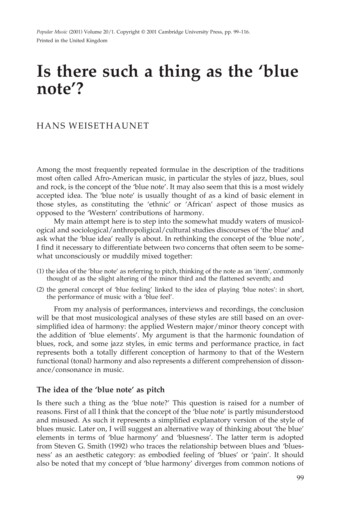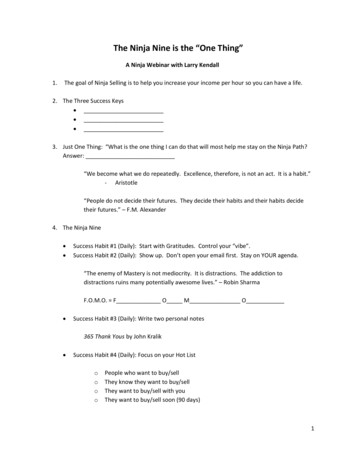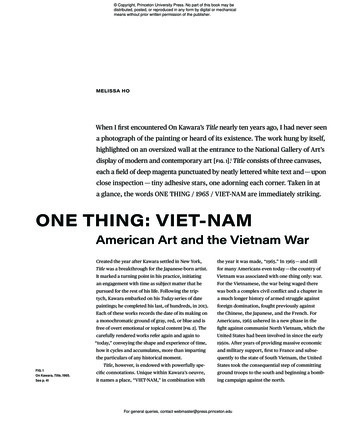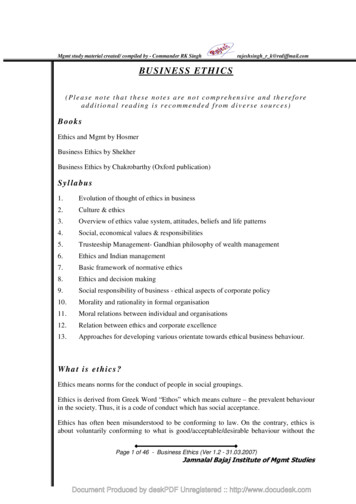
Transcription
Popular Music (2001) Volume 20/1. Copyright 2001 Cambridge University Press, pp. 99–116.Printed in the United KingdomIs there such a thing as the ‘bluenote’?H AN S W EI S ET H A UN E TAmong the most frequently repeated formulae in the description of the traditionsmost often called Afro-American music, in particular the styles of jazz, blues, souland rock, is the concept of the ‘blue note’. It may also seem that this is a most widelyaccepted idea. The ‘blue note’ is usually thought of as a kind of basic element inthose styles, as constituting the ‘ethnic’ or ‘African’ aspect of those musics asopposed to the ‘Western’ contributions of harmony.My main attempt here is to step into the somewhat muddy waters of musicological and sociological/anthropoligical/cultural studies discourses of ‘the blue’ andask what the ‘blue idea’ really is about. In rethinking the concept of the ‘blue note’,I find it necessary to differentiate between two concerns that often seem to be somewhat unconsciously or muddily mixed together:(1) the idea of the ‘blue note’ as referring to pitch, thinking of the note as an ‘item’, commonlythought of as the slight altering of the minor third and the flattened seventh; and(2) the general concept of ‘blue feeling’ linked to the idea of playing ‘blue notes’: in short,the performance of music with a ‘blue feel’.From my analysis of performances, interviews and recordings, the conclusionwill be that most musicological analyses of these styles are still based on an oversimplified idea of harmony: the applied Western major/minor theory concept withthe addition of ‘blue elements’. My argument is that the harmonic foundation ofblues, rock, and some jazz styles, in emic terms and performance practice, in factrepresents both a totally different conception of harmony to that of the Westernfunctional (tonal) harmony and also represents a different comprehension of dissonance/consonance in music.The idea of the ‘blue note’ as pitchIs there such a thing as the ‘blue note?’ This question is raised for a number ofreasons. First of all I think that the concept of the ‘blue note’ is partly misunderstoodand misused. As such it represents a simplified explanatory version of the style ofblues music. Later on, I will suggest an alternative way of thinking about ‘the blue’elements in terms of ‘blue harmony’ and ‘bluesness’. The latter term is adoptedfrom Steven G. Smith (1992) who traces the relationship between blues and ‘bluesness’ as an aesthetic category: as embodied feeling of ‘blues’ or ‘pain’. It shouldalso be noted that my concept of ‘blue harmony’ diverges from common notions of99
100Hans Weisethaunet‘blues harmony’, thought of as ‘patterns of harmony’ or harmonic progressions;and also from commonplace notions of ‘blue notes’ and ‘blues scales’. My conceptof ‘blue harmony’ aims at a description of a particular stylised blend of harmonyinherent in blues performance – but also partly transformed to other styles – suchas jazz and rock.The purpose of this essay is not to give a final definition of ‘the blue’ in music,but rather to raise a few questions which seem crucial to our understanding oftheoretical concepts of harmony applied and reworked in blues performance. Asknown, blues is also commonly understood as ‘form’. Having played and intenselylistened to blues music myself for more than twenty years, my experience hasalways been that ‘form’ is internalised by blues musicians in such a way that perception of formal structure (as understood in musicological theory) is not at allwhat is at issue in performance. Discussing the topic of ‘blue notes’ with numerous – well-known as well as lesser-known – blues musicians and scholars,1 hasfurther supported my view that the concept of ‘blue notes’ is derived from Westernmusicology and that the ‘blue note’ may not even exist as an element of emic theory:its origin was surely invented to describe the structure of ‘Negro’ music as opposedto that of European music:The blues structure, like ragtime, was an admixture of African influence (the call-andresponse pattern) and European harmonically derived functional form. But unlike ragtime,the blues were improvised and as such were more successful in preserving the original andmelodic patterns of African music . . . Harmony has already been mentioned as the basis ofblues structure in its later stages of development. (Schuller 1986 [1968], p. 38)The description of ‘blues structure’ here given by Schuller seems representative ofhow jazz and blues historians have imagined how blues music came into being,and the fact that ‘harmony’ is portrayed as the ‘basis of blues structure’. Blues isprimarily thought of as a mixture of ‘simple structural forms’ of harmony derivedfrom European music with the addition of the ‘Negro’s’ ‘hollering’ and ‘crying’ of‘blue notes’. As described by Stearns, blues harmony is thus thought to be simple:The harmony employed in the blues is another matter. It is pretty clearly derived fromEuropean music although coloured by the blue tonality of the cry. At its simplest, the harmony of the blues consists of the three basic chords in our musical language . . . These chordsare technically known as the ‘tonic’, the ‘subdominant’, and the ‘dominant’ . . . (Stearns 1957,p. 102)The view that music is foremost an expression of ‘structure’ – and in particularthat of ‘harmonic structure’ – has been the ruling ideology of Western musicology(including ethnomusicology) almost up to the present day. As such, the disciplineof musicology has in particular been ruled by the ideas of ‘complexity’ versus ‘simplicity’; the ‘developed’ versus the ‘primitive’; ‘art’ versus ‘folk’ and ‘pop’; ‘high’versus ‘low’, and so forth.2 Even though many scholars have come to assume that‘blues form’ often includes a wide range of variation from the basic I–IV–V, twelvebar form, the performance of blues is still commonly thought of as exegetic of‘simple form’ with the addition of ‘blue notes’ and sad lyrics. Thus the followingdefinition of blues is given by Frank Tirro:‘Blues’ refers to a style of music, a type of performance, a musical form, and a state of mind.Structurally, the chief characteristic of the musical form is a repeated harmonic pattern oftwelve-measures’ duration in 4/4-time. (Tirro 1993, p. 51)
Is there such a thing as the ‘blue note’?101In defining the ‘blue note’ (by quoting ethnomusicologist Bruno Nettl), Tirro – likemost jazz/blues writers and scholars – leans on the ever-repeated definition of thepast where ‘blue notes’ came to be classified as the pitch-altering of thirds andsevenths:A frequently mentioned characteristic of U.S. Negro songs is the so-called ‘blue note’, theflatted or slightly lowered third and seventh degrees in a major scale. The origin of thisphenomenon is not known, but it probably cannot be traced to Africa. Here is a musical traitwhich may, possibly, have come into folk music from practices of American Negro popularand jazz musicians. (Tirro 1993, p. 54)3I think Nettl is wrong in suggesting that the concept of the ‘blue note’ hasderived from the musicians performing this music. Rather it has originated fromthe scholars describing the music. In addition, in blues performance every note maybe bent or altered, but in different ways depending on style and how such notesappear in the harmonic texture. One of the most frequently heard ‘blue notes’ asregards pitch discrepancy in post-war electric guitar playing may be that of thebent fourth: this is commonly bent to include different pitches between the fourthand the fifth (and higher pitches as well). The second (which does not even appearin what scholars have named the blues scale) also seems to be a very common ‘bluenote’ feature of most blues guitarists’ repertoires: moving between the second andthe minor third in innumerable ways. In fact every note of the twelve-tone chromatic scale may appear in a blues tune, possibly also as ‘blue notes’,4 because microtonality, attack, and timbre variation are such essential parts of blues expression.The aesthetics behind this practice – being crucial to the ‘meaning’ of blues performance – is that of ‘putting things to the notes’ as described by B.B. King in his book,Blues Guitar Method:To me it’s more like the human voice. It’s like a person singing. It seems to say more andyou can feel it. It makes the sound sort of stimulating . . . I think in terms of not just playinga note but making sure that every note I play means something. You need to take time withthese notes. If you just play notes and not put anything into it, you’ll never have a distinctivestyle. You need to put yourself into what you are doing. It will set you apart from the personjust playing the guitar. In other words, make music. (King 1973, p. 15)The aesthetics of blues phrasing involves an idea of ‘personifying’ each andevery note. The master of blues performance may make his personal mark on eachnote – with a bend or a vibrato – in such a way that the skilled/socialised listeneronly needs to hear one single note in order to recognise and feel the presence ofthe sound of a B.B. King as being distinct from Albert King, Albert Collins, BuddyGuy, or players like Peter Green, Eric Clapton or Jimi Hendrix. This contrasts withthe idea of ‘musemes’ as the smallest item of ‘music’ – sometimes defined as aminimum of three notes, sometimes more ‘flexibly’. (For a summary of the relevanttheories of Philip Tagg and others, see Middleton (1990), p. 189.)Among the very few ever to have questioned the widespread mis-assumptionof what makes up the pitches of ‘blue notes’ is Jeff Todd Titon in his study of ‘earlydownhome blues’ (a term borrowed from the vernacular). From analysing a numberof downhome blues performances, Titon comes to the conclusion that in fact all thepitches of the Western twelve-tone scale may be used in one single blues melodyin this early performance style of the blues (Titon 1994, p. 154). Hence, Titon abandons the notion of ‘blue notes’ in favour of his own ‘pitch complexes’. Related tothe keynote of C he defines groups of pitches as ‘E complex’ (the series between E §and E), ‘G Complex’ (the series between G § and G), and ‘B § complex’ (the series
102Hans Weisethaunetbetween B § and B), which he finds to be the most frequently found microtones inthis style of blues, alongside movements including the notes A, F and D, while C(tonic) and G (the fifth) still seem to be the most important notes. Titon goes on toshow that this particular practice does not seem to be a play of chance but occurswithin a rather consistent system of melodic contour, lines and stanzas:. . . the most important argument that these quarter-tones form distinct pitches in a downhome blues mode is that singers enter and move within the complexes in a manner reasonably consistent from phrase to phrase, line to line, and stanza to stanza throughout a givensong. (Titon 1994, p. 159)Returning to Stearns (1957), data arguing for an alternative concept of ‘bluenotes’ seem to have been present also at that time; however, the emic utteranceswere rather used as a means of documenting the stubbornness and lack of theoretical understanding of the blues performer, for instance, the harmony employed byJohn Lee Hooker is viewed as lacking in development. As Stearns writes:There were blues singers on recordings in 1955, however, who still did not employ Europeanharmony. It is generally possible to date a blues style by the complexity of the harmony.Guitarist John Lee Hooker, whose recordings are made for Negro trade exclusively, employsa drone which sounds very much like the skirl of a bagpipe and he says his grandfatherplayed that way. His rhythms, however, are very complicated. With Big Bill Broonzy it’s amatter of pride not to employ European harmony, although he doesn’t think of it in thoseterms:. . . for me to really sing the old blues that I learned in Mississippi I have to go back to mysound and not the right chords as the musicians have told me to make. They just don’t workwith the real blues . . . the blues didn’t come out of no book and them real chords did . . .the real blues is played and sung the way you feel and no man or woman feels the sameway every day . . . (Stearns 1957, pp. 102–3)In considering later examples of blues performance, in particular that of postwar electric blues with representatives like B.B. King, Albert King, Freddie King,John Lee Hooker, Hubert Sumlin, Albert Collins, Otis Rush, Buddy Guy, JohnnyWinter, Stevie Ray Vaughan; players like Jimi Hendrix, Eric Clapton, Peter Green,Steve Cropper, Robert Cray, rockers like Eddie Van Halen or Jimmy Page, and evenjazz players like John Scofield, Mike Stern and John McLaughlin, my argument isthat what is at stake in blues is not simply a major/minor Western concept ofdiatonic practice with the addition of ‘blue notes’, but rather a completely differentconcept or reworking of functional harmony5 as regards the comprehension of dissonance/consonance. The simplified conceptualisation of what ‘blue notes’ areabout partly stems from the intense musicological insistence on separation ofelements of musical ‘structure’ derived from Western music theory: the insistenceon the separation of ‘harmony’ from ‘sound’ (timbre), ‘melody’ and ‘rhythm’, asthe starting point of all analysis.Music as process: ‘blue notes’ as participatory discrepanciesRather than thinking of music as the structure of ‘objects’, I think it is wise to viewmusic as a mode of performance: as a process involving musicians and participants.Following Charles Keil, ‘the power of music lies in its participatory discrepancies’:a concept Keil uses to describe the intentional ‘out-of-tuneness’ and ‘out-ofsyncness’ of music performance: the ‘process’ of ‘vital drive’, ‘groove’ or ‘beat’ andthe ‘texture’ of ‘timbre’, ‘sound’, ‘tone qualities’, etc. (Keil and Feld 1994, p. 96)A similar point of departure is taken by Robert Walser’s argument that music
Is there such a thing as the ‘blue note’?103Table. Layers of ‘sound’/‘harmonic texture’.LayersInstrumentsTexture(4) Lead:(3) Background:Melody, improvisation, linesRiff, chords(2) Reference:Vocal/lead guitar/saxGuitar/piano/organ/horns/backingvocals, etc.Bass guitar(1) Pattern:DrumsHarmonic foundation,arpeggios, lines, root (tonic)references, riffSound, attack, spaceshould be revived as a verb rather than a noun in order to challenge the commonpractice of analysing and understanding music in terms of objects. In doing so hetakes as a starting point Christopher Small’s notion of ‘musicking’ (see Small 1987and 1998): ‘Musicking embraces composition, performance, listening, dancing – allof the social practices of which musical scores and recordings are merely onedimensional traces.’ (Walser 1993, p. xiii)‘Blue notes’ may obviously be seen as ‘participatory discrepancies’ followingKeil’s definition which tries to capture the fundamental feature of participation,interaction and sociality of music performance. Seeing ‘grooving’ as fundamentallysocial, my assumption will be that ‘harmony’ must be viewed as part of what Keildefines as ‘texture’: ‘sound’, ‘tone qualities’ and so forth. What blues performancesof ‘Chicago style’ (Muddy Waters, Jimmy Reed, etc.), ‘Texas style’ (Clarence Gatemouth Brown, Stevie Ray Vaughan, etc.), ‘New Orleans style’ (Earl King, SnooksEaglin, etc.) and ‘British style’ (the Bluesbreakers, 1960s Fleetwood Mac, etc.) allhave in common is that their music is the outcome of an interaction of individualplayers creating the ‘sound’ or ‘texture’ of the blues in interplay. Each musician ofa band participates in creating the ‘whole’ – the music – by grooving and creatingsounds in real time. There may be expressed or unexpressed stylised rules governing this process; however, to be accepted as a musician (to be able to play the blues),some stylised regularities must be followed as a basis of performance.In performance, interplay (collaboration/communication) is based on the ideathat each player finds or defines his ‘space’ in relation to the others. At the bottomthere will be a keeper of the groove: usually the bass player and the drummer ininteraction. At the next layer there will be some rhythmic ‘lift-up-over-sounding’discrepancies: rhythm guitar or keyboards. On top, there will be vocals and leadguitar soloing. Together, all those layers make the ‘groove’, while simultaneouslycreating the ‘texture’.As regards ‘texture’, the opening up of ‘sound’ and ‘space’ is created by breaksand continuity in the rhythm pattern set by the drummer. The harmonic reference/foundation/root is initiated by the bass player, while chords and harmonic riffs areplayed on guitar/keyboard. On top of this the texture is filled with melodies andlines of lead vocals, lead guitar or possibly other instruments, like piano, sax, harmonica, etc. entering this role (see the Table, layer 4).The Table sets out a very simplified model of how ‘harmonic texture’ is setinto play in the process of a blues band performance. ‘Groove’ as process occurs atall layers, as does improvisation. What is of main concern here, however, is howthe concept of ‘blue notes’ fits within the process of the ‘harmonic texture’: what Iam going to term ‘blue harmony’. This interaction between the different layers,
104Hans Weisethaunetbetween different individuals, may also be the essence of the performance asregards ‘sound’ and ‘harmony’, as well as the core of the musical interactionbetween the members of a band. A man who came to influence the ‘sound’ of 1960sand 1970s soul, blues and rock performance to a great extent is guitarist and producer Steve Cropper, who recorded and produced artists like Albert King, OtisRedding, Wilson Picket, Eddie Floyd, Booker T & the MGs, etc., until he re-enteredthe stage as a ‘Blues Brother’ in the 1980s. Cropper, in an interview I conducted,especially speaks of ‘sound’ as the identification of different layers, and of different‘roles’ of the individuals in a band: the ambition ‘to fill in the holes’ of the wholetexture:I like to play licks that are of a rhythmic nature. That creates a feel; and a groove. And I liketo play in the holes, when the singer is not singing. I like to play stuff that compliments themelody; and really get involved in what the singer is trying to do. And I think that’s whereI am most valuable as a guitar player. (Weisethaunet, interview with Steve Cropper, 8 June1990)The concept of ‘sound’ is definitively even more complex than that of ‘harmony’, and in the way it is commonly used amongst musicians it incorporatesalmost every aspect of the musical performance. In what follows, my main argument is that neither ‘harmony’ nor ‘sound’ are elements as easily separable as isoften thought. From my analysis of a vast number of blues tunes and from theexperience of playing blues music, however, some simple conclusions might nevertheless be drawn as far as ‘harmony’ is concerned.If we stick with the Table above, it might be observed that at layer (1) a patternor framework of ‘groove’ is laid down by the drummer. As regards texture, thispattern will create a temporal reference which will be varied, broken down orchanged at certain points, creating both high and low end sounds and the essential‘opening up’ and ‘closing’ of space in the texture. At layer (2) the bass player willusually stay close to the roots of the actual chords or create patterns that will fitwith the basic structure employed according to each song. Usually this implies amajor tonality. (Minor blues forms occur but are rather to be seen as a variant thatdiffers from the main formula.) If the ‘simplest’ twelve-bar form is followed, thebass will indicate the chords I–I–I–I–IV–IV–I–I–V–IV–I–V. The bass player will usually hold on to this harmonic foundation, and at its very simplest create walkinglines (or ostinato) of notes 1–3–5–6: the arpeggio of the major chord with the possible addition of the sixth. At layer (3), however, rhythm guitar or piano may imposemajor chords, but more commonly they will in blues rather employ sevenths (1–3–5–§7), ninths (1–3–5–§7–9), thirteens or diminished chords, etc. In the style of contemporary (1990s) blues commonly heard in Texas (such as on the scene in Austin,among players like Jimmie Vaughan, Jesse Taylor, John McVey, Ian Moore, AlanHaynes and Chris Duarte), one of the most common rhythm chords used at thislayer seems to be the 3–§7–9–5 (a voicing of a ninth chord, with root omitted) or §7–3–6–1 (a voicing of a 13th chord with the root on top and fifth omitted). On top ofthis, however, the most ‘naturally’/‘emic sounding’/‘diatonic scale’6 on the I chordis neither the major scale (as should be indicated by the bass line) or the mixolydianscale (as should be indicated by the chords at layer (3)), but rather the notes of thedorian scale: 1–2–§3–4–5–6–§7–8.My argument here is that the dorian scale (which also may be seen as what isnamed the ‘blues scale’ with, however, the addition of the significant notes 2 and
Is there such a thing as the ‘blue note’?1056) sounds ‘less dissonant’ to blues performers and listeners when applied againstthe foundation of a major-oriented bass line – in a texture usually featuring variations of seventh chords – than the major scale. Blues players will also employ themajor third in their solos and phrases; however, if this is overdone, it will take thefeeling away from that of the blues and make the music sound more ‘jazzy’ or‘country-like’. From the perspective of the blues performer and listener, the majorthird against the major chord may thus sound more ‘dissonant’ than the applicationof the minor third over the major chord!7 Seeing the idea of the ‘blue note’ in sucha context, it seems clear that the texture of ‘blue harmony’ involves a specific comprehension of harmony that becomes neglected if ‘harmony’ and ‘melody’, orchords and solos, are analysed entirely separately from each other. In what follows,I will illustrate by examples how such an application of ‘blue harmony’ seems acommon characteristic of the style of blues performance.‘Blue harmony’ – a different conceptThe concept governing Western functional harmony (at least in theory and up to acertain point in history) is the diatonic principle: in short, the C-major scale workswith C-major, a-minor, G7, e-minor, d-minor chords, and so forth. However,C-minor scales are not considered to go along with C-major chords: this will usuallybe thought of and experienced as ‘dissonance’. In the texture of ‘blue harmony’,however, this does not sound ‘dissonant’ at all to blues people. That is why I thinkthe concept of ‘blue harmony’ may be a good one, as it is experienced as a kind ofmode of texture which is known from the blues, but which is not limited to thisgenre/style.8 It is also likely to enter into rock as well as jazz, soul, reggae and otherAfrican–American influenced popular musics. As Walser points out:Heavy metal, like all forms of rock and soul, owes its biggest debt to African–Americanblues. The harmonic progressions, vocal lines, and guitar improvisations of metal all relyheavily on the pentatonic scales derived from blues music. (Walser 1993, p. 57)9Before this argument is taken any further, I will give a few examples of how myidea of ‘blue harmony’ has derived from analysis of the harmonic texture of bluesperformances. The word ‘texture’ seems to be a good one since ‘blue notes’ neverappear as isolated ‘items’. Often the performer will play two or three notes simultaneously – also in solo guitar playing – and the effect of ‘blue harmony’ seems tobe created by the way those are voiced; put together; imposed, in accordance withthe rest of the texture. As such blues is to be experienced as tonal music; there is inblues always a tonal centre; it is a play within a tonal framework. Blues is hardlyever ‘a-tonal’, as may be the case with Western non-functional musics.Example 1 shows one of the most commonly heard ‘blue’ constellations ofnotes. It seems to occur in most blues guitar players’ repertoires: as in the beginningof Eric Clapton’s version of ‘Ramblin’ on My Mind’ (from the LP, John Mayall,Bluesbreakers with Eric Clapton, Decca, 1966). When played ‘right’, this example mayalmost sound like the whistle of a train, one of the core metaphors of blues mythology. It is a very common lick, and Clapton probably ‘got it’ from Robert Johnson’splaying. Note, however, that the notation here is a reduction of the musical texturalcomplexity, i.e. the notation is a representation of what is played but, on paper,definitively a reduction of the way it ‘sounds’. As such, these examples are boundto a particular performance technique but also to the intrinsic qualities of the guitar
106Hans Weisethaunetas an instrument (a pianist would have to approach the examples very differently).For the sake of simplicity, the examples are transcribed in the key of C.Imposed over a C major (I) chord, the ‘lick’ in Example 1 consists of notes §3 5, which is like imposing the minor chord over the major. Functionally, the §3could also be explained as the #9, but that does not change the effect. When thechord changes to IV (subdominant) (F), the same ‘lick’ may still be played, but itsfunction has changed: to §7 9.§3 5Example 1.Another ‘lick’ which is commonly applied on the I chord is shown in Example2. This ‘lick’ consists of notes 6(13) §3. When applied against the IV chord(subdominant) rather than on I (tonic) – which is also very usual – it changes itsfunction to 3 §76(13) §3Example 2.Example 3 is a very common ‘lick’ heard in Stevie Ray Vaughan’s playingwhich includes an interchange (constant shift/‘hammer on/off’) between the minorthird and the fourth. This is usually also played over the background of a major orseventh chord (initiating a style of guitar playing which is also a typical feature ofthe music of John Lee Hooker).Example 3.One of the most used ‘riffs’ in blues rhythm guitar playing is shown inExample 4, and involves a constant shift – or a kind of a trill – between §3 and 3,and it is used by everyone from B.B. King to Stevie Ray Vaughan, Robert Cray,Clapton, etc.Example 4.
Is there such a thing as the ‘blue note’?107In general, blues phrasing is based on a very subtle play of tonality, whererhythmic attack, microtonality and bending of strings creating an interplay betweenmajor and minor – but also other – intervals is of the essence. Among the performances where the kind of trill between §3 and 3 shown in Example 4 may be heard,is Stevie Ray Vaughan’s recording of the blues ‘Texas Flood’ (written by LarryDavis and Joseph W. Scott), from the album, Stevie Ray Vaughan and Double Trouble, Texas Flood (Epic/CBS, 1983), cf. the G chord in the very beginning. The transcription which follows (adapted from Vaughan 1995, p. 20, transcribed by JesseGress) is in G major; however, the tune is played in G §. The reason why it is notatedin G is that Stevie Ray Vaughan, like Hendrix, usually tuned his guitar down halfa step, from E tuning to E § tuning, in order to obtain a ‘fatter’ sound by allowingthe use of heavier gauge strings without reducing the ability to perform large bends.After the introduction, displaying in particular 6th and 9th chords, the second lineof notation here, from the third complete bar, shows some very typical Stevie RayVaughan bends: the 4 is bent higher than §5 almost to 5, then the line goes: 5 – 1′ –§7 bent almost to 1′ – 5 – 2′ – 1′ – §2′ (§9) – 1′ – §7 – 1′ – §3′ bend to 4′ – §3′ bent to3′ – 1′ – 5 – 4 bent to §5 – then §3 is bent to 4 (a well-marked bend also frequentlyheard in the playing of Buddy Guy) – 1 – 1 – and §3 slightly bent against 3, beforethe line ends on 1, then 4 – §5 – 5: leading into the dominant seventh. (I have usedthe sign ′ just to indicate moves to an octave above.)Example 5. ‘Texas Flood’ (Davis, Larry/Scott, Joseph W.) 1958 Duchess Music Corp./Universal/MCA Music Ltd. Used by permission.Example 6, extract from ‘The Same Way’ by Peter Green (from the LP, JohnMayall, A Hard Road, Decca, 1967, my transcription) shows a segment of one ofBritish guitarist Peter Green’s typical blues lines. The tune is clearly based inA-major tonality, with ‘shuffle’-comping rhythm guitar typical of a blues/rock style.Introducing the solo is an E (dominant) chord; however, a second and third guitarplay a simple riff which includes the notes c, b, a (§3, 2, 1), also indicating a minortonality. (While one guitar plays this melodic line, another guitar, however distorted, strums the full chords C, B(m) and A, underneath this line.) The overalltonality, however, is A major. In his solo, Peter Green begins by playing a significant1, §7, §3 line. In bar 3, he makes a bend from the second to §3 and back. In bar 4, hemakes a very significant bend from the fourth (D) to a note slightly higher than the§5 (E §). Then notice how he fuses major and minor tonality in the outgoing triplet
108Hans Weisethaunetline (bar 5). First there is a slight indication of a minor third in front of the majorthird: then the line goes 3′–5′–4′–§3′–1′–5–4–3. Green is typically enough using bothmajor and minor thirds in the same line, and ending up on the major third anoctave below.Example 6. ‘The Same Way’ by Peter Green 1967 Getaway Music Ltd. Transcribed by H. Weisethaunet. Used by permission.As already pointed out, the texture in which lines and riffs occur consists ofseveral layers that will give an overall picture of ‘blue harmony’ which is quitecomplex, and much more complex than presented here. Neither does the notationfeature pitch discrepancies (which are essential to the feel of the overall texture),give any indication of sound/timbre, or point out how the notes appear rhythmically in accordance with what is happening in other layers. My main point, however, is not that of ‘complexity’, but the simple fact that the notion and definitionof ‘blue notes’ most commonly applied to blues perform
‘Blues’ refers to a style of music, a type of performance, a musical form, and a state of mind. Structurally, the chief characteristic of the musical form is a repeated h











